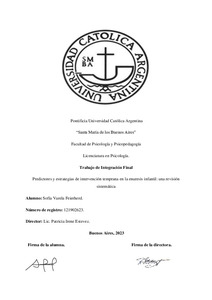Please use this identifier to cite or link to this item:
https://repositorio.uca.edu.ar/handle/123456789/18376| Título: | Predictores y estrategias de intervención temprana en la enuresis infantil: una revisión sistemática | Autor: | Varela Feierherd, Sofía | Director de Tesis: | Estévez, Patricia Irene | Palabras clave: | ENURESIS; NIÑOS; REVISION SISTEMATICA | Fecha de publicación: | 2023 | Cita: | Varela Feierherd, S. Predictores y estrategias de intervención temprana en la enuresis infantil: una revisión sistemática [en línea]. Trabajo Final de Grado. Pontificia Universidad Católica Argentina, 2023 Disponible en: https://repositorio.uca.edu.ar/handle/123456789/18376 | Resumen: | Introducción: La enuresis infantil es una patología bastante común dentro del ámbito
pediátrico. Esta patología a su vez, puede dividirse entre primaria o secundaria y los factores
que podrían provocar cada una de éstas, son diferentes. Mientras que la enuresis primaria tiene
más relación con aspectos biológicos, la secundaria se relaciona con aspectos psicológicos y
emocionales. Por otra parte, se ha comprobado que esta patología tiene un gran impacto dentro
del entorno familiar también. Por tanto, uno de los recursos necesarios para lograr el
afrontamiento eficaz de la enfermedad, no es únicamente tratar tempranamente a los niños, sino
que también es relevante incluir a los padres en estos tratamientos, con el objetivo de que logren
comprender en profundidad la enfermedad de su hijo y sepan cómo acudir y cómo tratar la
enuresis. Se ha demostrado que muchos padres, como consecuencia de su ignorancia frente a
la enuresis, suelen castigar a sus hijos cuando éstos tienen estos episodios haciéndolos sentir
culpables y generando menores probabilidades de lograr la continencia. Resultados: Se
revisaron 55 artículos para poder reconocer qué factores afectan a la enuresis primaria y la
secundaria y cómo se diferencian. Además, se revisaron 34 artículos sobre las intervenciones
que podrían generar mejores resultados. Finalmente, se evaluaron 16 artículos que probaron la
eficacia de las diferentes intervenciones encontradas para los niños y para los familiares.
Conclusiones: Se deja en evidencia la necesidad de incluir a los padres en los tratamientos de
niños con enuresis con el objetivo de lograr resultados positivos. Introduction: Enuresis in children is a fairly common pathology in the pediatric setting. This pathology in turn, can be divided into primary or secondary and the factors that could cause each of these, are different. While primary enuresis is more related to biological aspects, secondary enuresis is more related to psychological and emotional aspects. On the other hand, it has been proven that this pathology has a great impact within the family environment as well. Therefore, one of the necessary resources to achieve effective coping with the disease is not only to treat children early, but it is also highly relevant to include parents in these treatments, so that they can gain a deep understanding of their child's disease and know how to go and how to treat bedwetting. It has been shown that many parents, as a consequence of their ignorance about enuresis, tend to punish their children when they have these episodes, making them feel guilty and thus generating less probabilities of achieving continence. Results: Fifty-five articles were reviewed in order to recognize what factors affect primary and secondary enuresis and how they differ. In addition, 34 articles were reviewed that aimed to demonstrate which types of interventions could generate better outcomes. Finally, 16 articles that tested the efficacy of the different interventions found for children and for family members were evaluated. Conclusions: The need to include parents in the treatment of children with enuresis in order to achieve positive results is evident. |
URI: | https://repositorio.uca.edu.ar/handle/123456789/18376 | Disciplina: | PSICOLOGIA | Derechos: | Atribución-NoComercial-CompartirIgual 4.0 Internacional | Fuente: | Trabajo Final de Grado. Pontificia Universidad Católica Argentina, 2023 |
| Appears in Collections: | Licenciatura en Psicología |
Files in This Item:
| File | Description | Size | Format | |
|---|---|---|---|---|
| predictores-estrategias-intervencion.pdf | 808,86 kB | Adobe PDF |  View/Open |
This item is licensed under a Creative Commons License

